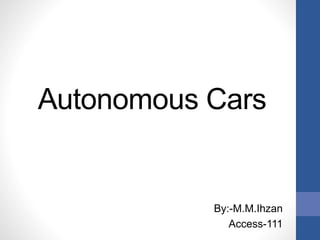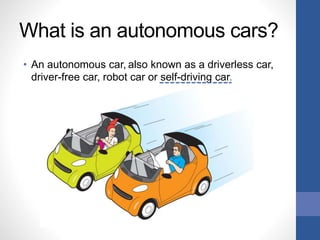Autonomous cars
- 1. Autonomous Cars By:-M.M.Ihzan Access-111
- 2. Contents • What is an autonomous cars? • Features of self-driving cars • What Does the Car Look Like? • How does it work? • Diagram of Self-Driving car • Laser Scanner • Radar • Cameras • Processor • GPS Antenna • Range of Scanners, Radars and Cameras • Traffic Ahead • Test Drive • Advantages and Disadvantages • Conclusion • References
- 3. What is an autonomous cars? • An autonomous car, also known as a driverless car, driver-free car, robot car or self-driving car.
- 4. What Does the Car Look Like?
- 5. Features of self-driving cars • A self-driving cars are capable of  Sensing its environment  Navigating without human input.  Fulfilling the human transportation capabilities of a traditional car.  Making intelligent decisions. • Maintaining an internal map and using that map to find an optimal paths. -Ex. road structures, pedestrians and other vehicles
- 6. How does it work? • The vehicle build a map of its environment and precisely localize itself within that map.  It uses laser rangefinders and cameras. • The vehicle uses a probabilistic model to track the predicted future path of moving objects based on its shape. • Intelligence and makes decisions on its own (if mistake is made it will alert driver) • It use its GPS to know where it is in relation to other objects in the map. • It use inertial navigation unit, and sensors to precisely localize itself.
- 7. Diagram of Self-Driving car GPS Antenna Cameras Laser Scanner Processor Radar Radar Laser Scanner
- 8. Laser Scanner • The laser gives 360 degree understanding. • Car can sense objects at the same time. • The laser helps to determine its location.
- 9. Radar • Radar detects vehicles far ahead. • Radar calculate other vehicles speed.  So car can speed up or slow down with other vehicles.
- 10. Cameras • The cameras detects traffic lights. • It helps car’s onboard computer to recognize moving objects. -Ex. Pedestrian, bicycles
- 11. Processor • Processor measures small movements made by the car. • It helps to accurately locate its positions on the map.
- 12. GPS Antenna • Its helps to know where it is in relation to other objects in the map. • As the vehicle moves, new positional information and sensor data are used to update the vehicle’s internal map.
- 13. Range of Scanners, Radars and Cameras Short-range radar Range of 0.2m to 30m Mid-range scan Range of 60m Long-range radar Range of 200m Camera Visual range of up to 500m 30m 60m 200m
- 14. Traffic Ahead • Many carmakers developing prototype vehicles that are capable of driving autonomously in certain situation. BMW Mercedes-Benz Nissan Google General Motors Vehicles 5 Series (modified) S 500 Intelligent driver research vehicle Leaf EV (modified) Prius and Lexus (modified) Cadillac SRX (modified) KEY Technologies • Video camera tracks lane markings and reads road signs. • Read sensors detect objects ahead. • Side laser scanners. • Ultrasonic sensors. • Differential GPS. • Very accurate map. • Stereo camera sees objects ahead in 3-D • Additional cameras reads road signs and traffic lights. • Short and long range radar. • Infrared camera, • Ultrasonic sensors. • Front and side radar. • Camera • Front, side and rear laser sensor, • Fore wide angle cameras shows the driver the car’s surroundings . • LIDAR on the roof detects objects around the car in 3-D • Camera helps detect objects. • Front and side radar. • Inertial measuring unit tracks position, • Wheel encoder tracks movement. • Very accurate map. • Several laser sensors. • Radar • Differential GPS • Cameras • Very accurate map.
- 15. Test Drive • Already sent out vehicles (over 140,000 miles through traffic, residential, and highway) • Nevada-June 2011 • Florida-April 2012 • California-September 2012 • Texas-September 2012 • Trying to find green alternatives.
- 16. Advantages • React faster than humans. • 360 degree perfection. • Allows more people to commute. • Cannot get distracted, sleepy, or intoxicated. • Actively engage the driver (announcements like “approaching a crosswalk” or “turn ahead”) Disadvantages • Expensive. • Cars reducing more carbon. • Costs more gas. • Some times make wrong decision.
- 17. Conclusion • “Actually, I think it is a great idea once the technology is perfected and locked down. • Sure we can't imagine something like it now, but think off into the future.”
- 18. Questions?
- 19. References • http://robohub.org/how-do-self-driving-cars-work/ • http://images.gizmag.com/inline/stanford-audi-tts-autonomous-car-race- car-drivers-thunderhill-raceway-9.jpeg • http://www.blogcdn.com/www.autoblog.com/media/2012/02/googlea utonomous-car-628.jpg • http://www.autonomos.inf.fu-berlin. de/escape/sensors/migsensors/sensors/MIG_labels.jpg • http://www.extremetech.com/wp-content/uploads/2012/04/google-self- driving-car-537x369.jpg • http://www.extremetech.com/wp-content/ uploads/2013/06/MercedesDistronicPlusThruWindshieldIllo- 640x381.jpg • http://images.gizmag.com/gallery_lrg/volvo-autonomous-cars-42.jpg • http://cnet3.cbsistatic.com/hub/i/r/2010/03/26/9fc59e0c-f0fc-11e2- 8c7c-d4ae52e62bcc/ thumbnail/170x128/6f07b19564357d3844b8674571f00 12c/AudiShelley-2.jpg • http://www.mobilemag.com/wp-content/uploads/2009/08/nissan.jpg
- 20. Thank you



















